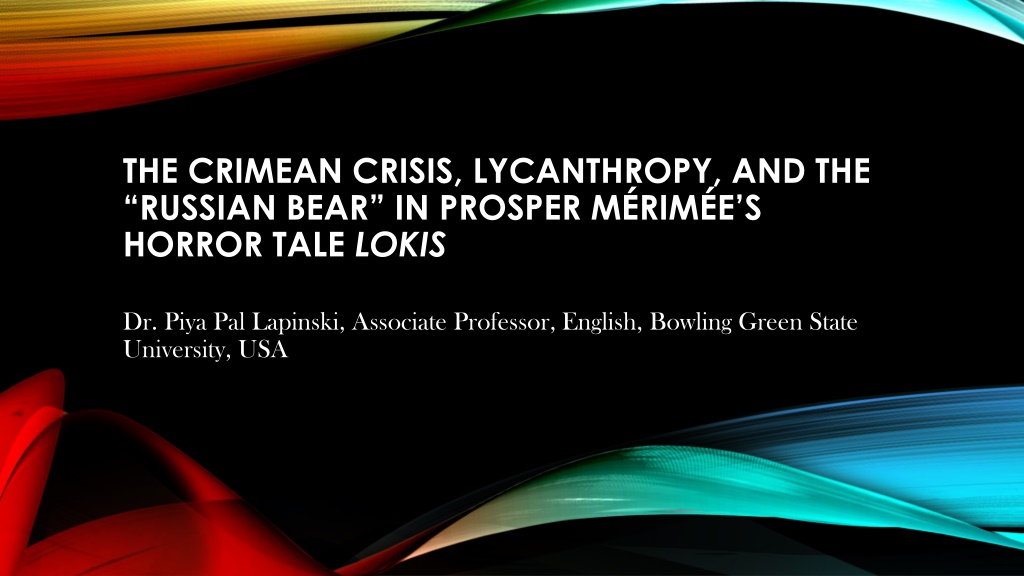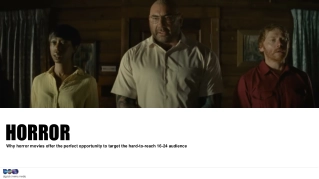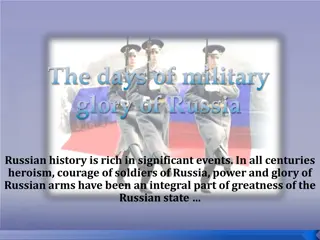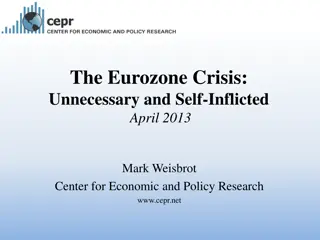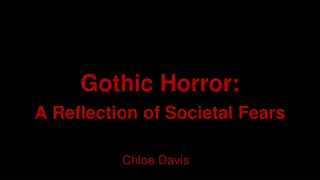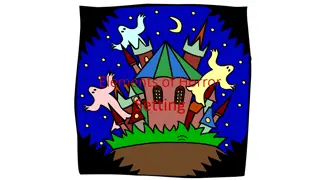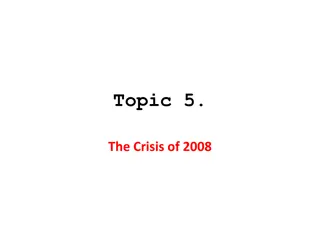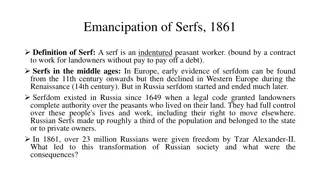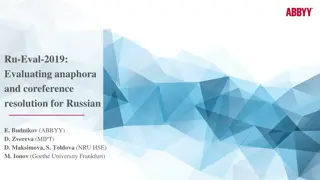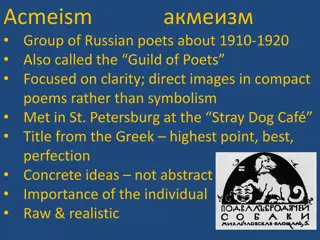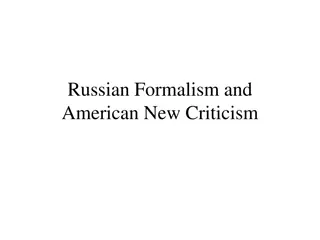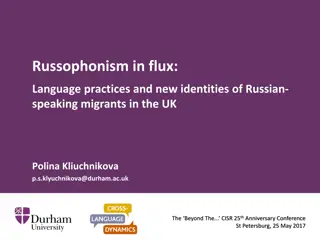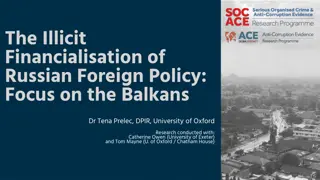The Crimean Crisis, Lycanthropy, and the Russian Bear in Prosper Mérimée's Horror Tale "Lokis
In 1869, French writer Prosper Mérimée penned "Lokis," intertwining vampirism and lycanthropy in a tale that connects the violent Count Szémioth with the Crimea conflict. Analyzing the narrative through the lens of linguistic hybridity, geopolitical conflicts, and the symbolic imagery of the Russian Bear, the story delves into the limits of humanity, language, and territorial disputes.
Download Presentation

Please find below an Image/Link to download the presentation.
The content on the website is provided AS IS for your information and personal use only. It may not be sold, licensed, or shared on other websites without obtaining consent from the author. Download presentation by click this link. If you encounter any issues during the download, it is possible that the publisher has removed the file from their server.
E N D
Presentation Transcript
THE CRIMEAN CRISIS, LYCANTHROPY, AND THE RUSSIAN BEAR IN PROSPER M RIM E S HORROR TALE LOKIS Dr. Piya Pal Lapinski, Associate Professor, English, Bowling Green State University, USA
SYNOPSIS In 1869, French writer Prosper M rim e wrote Lokis, a tale mixing vampirism with lycanthropy, which he read out loud to the Empress Eugenie and her friends. In Lokis, a Lithuanian aristocrat, Count Michael Sz mioth, is revealed to be half-man, half-bear. The story connects Sz mioth s violence with the violence at Sebastopol in Crimea. I argue that M rim e s tale is a brilliant twist on the image of the Russian Bear which emerged in the media during the Crimean War in the lithographs of Honor Daumier, and in Punch in Britain. The intertwined motifs of linguistics and lycanthropy in Lokis raise questions about the limits of the human, the connections between language, hybridity and violence, and the borderlands caught in the territorial conflicts between Turkey, Poland-Lithuania and Russia.
PROSPER MRIME, LOKIS (1869) Lokis (Lithuanian for bear) was read aloud by M rim e to the Empress Eugenie and her nieces in the summer of 1869 Aves-vous compris, vous? Narrated by Professor Wittenbach, a scholar and linguist, the tale describes his visit to the castle of a Lithuanian aristocrat, Count Michael Sz mioth Sz mioth s mother had been raped by a bear prior to his birth, and lost her reason On his wedding night, the Count transforms into a bear and kills his Polish-Lithuanian bride, Julka
CRITICAL VIEWS ON LOKIS Lokis stages the convergence of the trope of borderlands torn by war and crisis with that of internal borders (relating to animal and human); there is both vampirism as well as lycanthropy in Sz mioth s final, violent transformation. the young countess was stretched out dead on her bed, her face hideously lacerated, her throat torn open, and drenched in blood (Lokis 330) Most critical readings of Lokis have focused on the complex discussion of linguistic hybridity within the narrative, and the human-beast binary. Mich le Simonsen, in Nature et Culture Dans Lokis de M rim e asks: la sauvagerie du comte est- elle imputable a sa nature animale ou a sa nature humaine? Est-elle l exception ou est-elle la r gle? I depart from some of these readings by reading Lokis against the geopolitics of the Crimean War (1853-1856), the conflict between Russia and Turkey, and the contested borderlands of Lithuania and the Crimea. I also read the trope of the bear in terms of political cartoons of the Russian bear triggered by Russian expansionism.
GEOPOLITICAL CONTEXT: CRIMEAN, TURKISH AND POLISH REFERENCES IN LOKIS Lokis opens with a conversation between Prof. Wittenbach and the Countess s physician, who describes in graphic detail the violence in Sebastopol during the Crimean War. The references to the Crimea are punctuated by stories of the mad Countess s violence towards her infant son, and her husband s bear hunts. Soon after, the professor senses a heavy animal in the tree outside his bedroom window. In the morning, he meets Count Michael, wearing a Bokhara dressing gown and with a long Turkish pipe in his hand.
THE THREE SONS OF BOUDRYS Count Sz mioth also reads a Polish ballad by Polish poet Adam Mickiewicz (1798-1855) to Wittenbach. The ballad concerns the sons of the Lithuanian Boudrys and their search for a Polish bride. It foreshadows Julka s death at the end. The theme of the captive Polish bride is mirrored in a famous poem on the Crimean Khans by Alexander Pushkin, The Fountain of Bakchisaray (1821-23). Pushkin had visited the ruins of Bakchiserai palace in 1820 after the annexation of the Crimea by Russia in 1783, and the subsequent Russification of the region. These 2 Romantic allusions in Lokis, further evoke the geopolitical subtext involving the Crimea, Lithuania, and the Russo-Turkish conflict that I am tracing here.
THE CRIMEAN KHANATE, THE OTTOMAN EMPIRE, AND RUSSIA The Crimean War in 1853 marked the culmination of two centuries of conflict and a series of wars between the Russian and Ottoman empires. The Crimean Khanate, ruled by the Giray dynasty, was a vassal state of the Ottomans prior to the Russian takeover. The Tatars of Crimea had stood in the way of Catherine of Russia s project of both Christianization and Russification of the borderlands caught between Turkish and Russian influence. Although Russia annexed the Crimea in 1783, the Allied Powers (Britain, France, and Piedmont-Sardinia) entered into a war with Russia in the mid 1800s to protect Turkey and check Russian expansionism. Similar to the Crimea, Lithuania was also a contested borderland under the shadow of Russian aggression. It merged with Poland to form the Polish-Lithuanian Commonwealth in 1569, which was further partitioned by Russia in the late 1700s. The January Uprising of 1863 against Russian control, occurred a few years before Lokis was written. Lithuania was also torn between Christian Polish influence, and a more elemental, pagan native Lithuanian culture. Lokis connects these two regions and their political crises through an elaborate set of references; making the trope of Sz mioth s violent transformation into a bear resonate on multiple levels.
LYCANTHROPY/VAMPIRISM IN THE TEXT OF LOKIS What then, do the themes of lycanthropy and vampirism symbolize in this strange, allusive horror tale written during the dismemberment of these borderlands caught between Russia and Ottoman Turkey in the mid to late 19th century? In myth, werewolves were often associated with Livonia (also under the threat of Russian influence). Scholars have noted also a tendency for eye witness accounts of lycanthropy (the transformation of a human being into a wolf; in the case of Sz mioth, a bear) to emerge in the context of war. By the 19thcentury, lycanthropy had become classified as form of mental disease. Is Sz mioth symbolic of Russia (Russia was visualized repeatedly as a bear in countless political cartoons of the time one of the most well known by French satirist Honore Daumier; and continues to be in our current time see following slides). Or does Szemioth (with his Turkish and Lithuanian associations); symbolize the ethnic splits and tensions in the borderland regions tensions which were to lead to ethnic cleansing, migrations and population exchanges? Does the split between bear and vampire and the search for and assault on the Polish bride signify the violent internal ruptures within the Polish-Lithuanian Commonwealth, menaced by external forces such as Russia and Turkey? Is the violence at the end of Lokis a crossing of the line between nature and culture, or a more fraught and complex crossing of boundaries between national and ethnic identities? Is it ultimately a commentary on the violence of Russia s imperial identity?
THE RUSSIAN BEAR IN POLITICAL ART: DAUMIER, THE NORTHERN BEAR (1854); JOHN TENNIEL, TURKEY IN DANGER, PUNCH, (1853)(BRANDEIS UNIVERSITY ARCHIVES)
CHRIS RIDDELL, IN THE GUARDIAN, THE RUSSIAN BEAR ADVANCES ON KYIV , 26 FEB, 2022
WALTER BENJAMIN, CRITIQUE OF VIOLENCE In his essay Critique of Violence, Benjamin explains the distinction between violence sanctioned by the state-- the legal military violence that often lies at the origin of state formation; and unsanctioned violence which exists outside these limits. The origin of every contract points towards violence. (the marriage contract in Lokis also signifies political and territorial contracts). The state, in establishing its borders, disavows this lawmaking violence by divesting the individual as a legal subject, of all violence In the great criminal, this violence confronts the individual with the threat of declaring a new law
VIOLENCE IN LOKIS My reading: Count Sz mioth s violent transformation into an animal and his vampiric destruction of the marriage contract in Lokis suggests the complicated forms of violence enacted in the process of redrawing the limits of certain regions such as the Crimea and Lithuania as a result of the Russo-Turkish conflict over borderlands. Instead of merely signifying a human/animal, nature/culture split, the vampiric and lycanthropic man- bear in Lokis might stand for the split between Muslim vs Christian, Christian vs pagan, aristocrat vs peasant, Poland vs Lithuania, and the Crimea vs the greater powers Russia and Turkey. This transformation, then, can be read on many different levels, both historically and theoretically--- as manifesting the originary violence that Benjamin speaks of,(both ethnic and religious) at the heart of remaking the geopolitical map in the interest of territorial/imperial expansionism.
REFERENCES Benjamin, Walter, Critique of Violence, in Selected Writings, Volume 1 1913-1926, Cambridge: Harvard University Press, 1996. Figes, Orlando, The Crimean War: A History, New York: Picador, 2010. Fudeman, Kirsten, Linguistic Science and Mystification in Prosper M rim e s Lokis , Nineteenth-Century French Studies, Vol. 40, 1-2, 2011-12, 112-126. Donecker, Stefan, The Werewolves of Livonia :Lycanthropy and Shape-Changing in Scholarly Texts, 1550=1720, Preternature: Critical and Historical Studies on the Preternatural, Vol 1. (2), 2012, 289-322. M rim e, Prosper, Lokis in Carmen and Other Stories, trans. Nicholas Jotcham, Oxford: Oxford University Press, 1989 Pushkin, Alexander, The Fountain of Bakhchisaray, in Selected Poetry, trans. Antony Wood, Penguin Classics, 2020. Simonsen, Mich le, Nature et Culture Dans Lokis de M rim e, Litt rature, October 1976, 23, 81-93.
